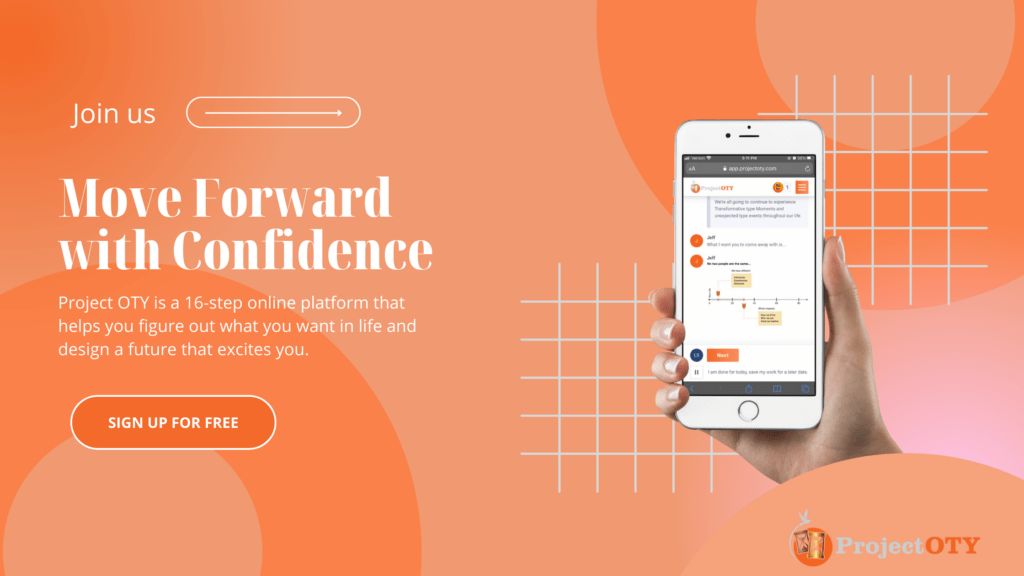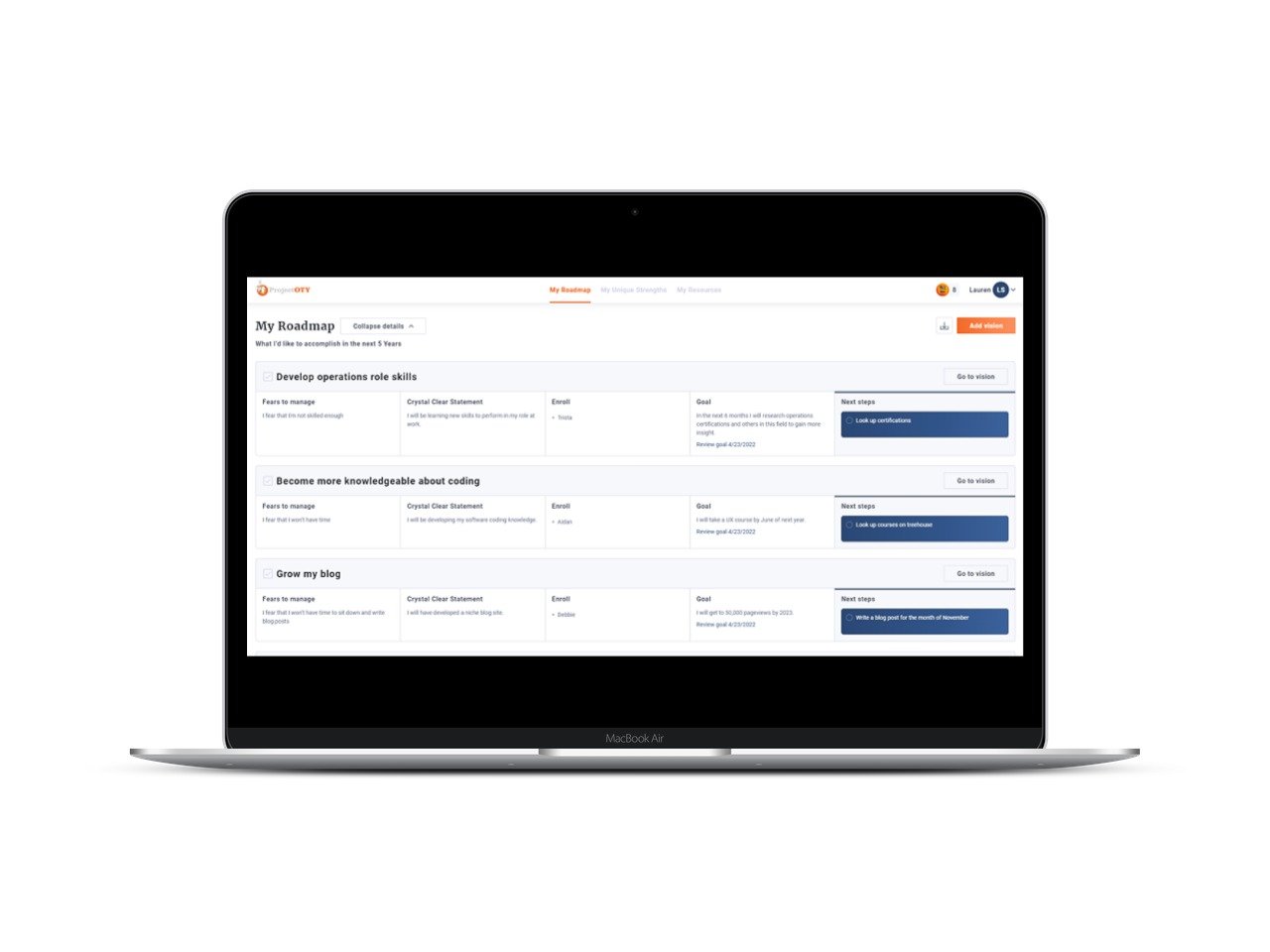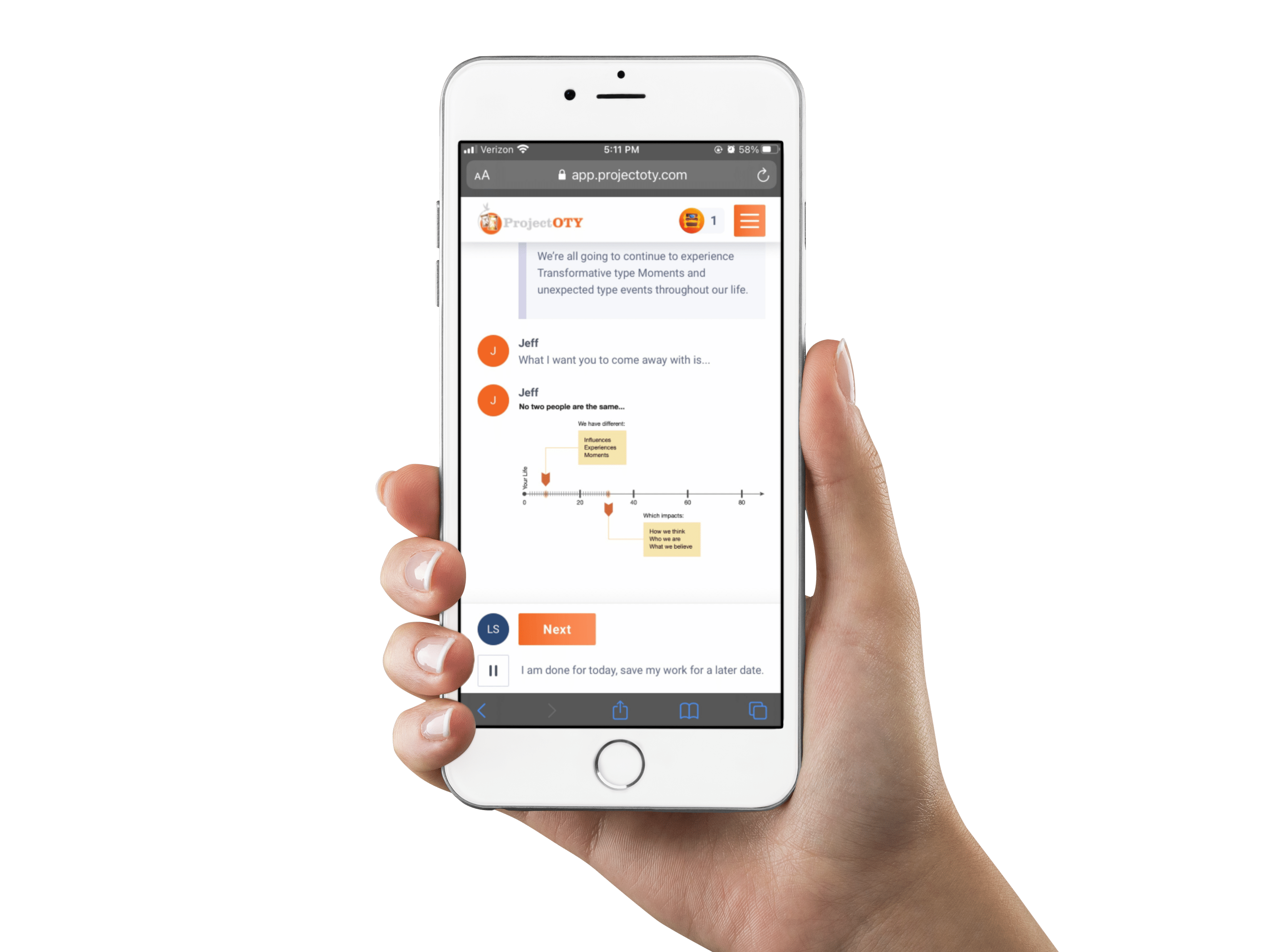Developing a mental concept of your future self and reality in your mind – is essential.
From there, you can take action to make it a reality and find the appropriate help along the way.
Visualization may feel like an exercise that you already do on a daily basis, so you might be wondering “Why do I need a lesson here?” Or, it may feel too touchy-feely to warrant much time and attention.
To that, we encourage you to commit time to learning to visualize your future fully. It’s the start of a major journey to create the world you want to live in. The person who most benefits from this, is you.
Only when you know what you want and are able to specifically understand the “what” and “why”, can you actually determine the “how” for achieving it.
“I believe that visualization is one of the most powerful means of achieving personal goals.”- Harvey Mackay
Here’s what you need to know about future visualization and the steps to visualizing your future self.
Our platform, Project OTY, will then take you one step further to organize all your future visions into an intuitively designed plan of action you can use to plan, track, and achieve what you want in life. (You can get started with a free trial here.)
What Is Self-Visualization?
The concept of self-visualization has become more prominent in daily culture since its noted use by the Soviets in the 1970s when competing in sports.
Sports icons throughout history, like Muhammed Ali and World Champion golfer, Jack Nicklaus reportedly used visualization practices to prepare and set their mindset up for victory.
Self-visualization is the act of defining the future self, based on present knowledge of goals, hopes, and dreams. This mental exercise is focused on being both realistic and balancing the good outcomes with the pressing challenges and negative outcomes.
This is where self-visualization and positive psychology, intersect with negative visualization. This concept goes back even further to ancient Rome, where it was used by Stoic philosophers like Marcus Aurelius to imagine negative outcomes and prepare accordingly.
Today, the concept is in practice by CEOs, like Jason Fried of Basecamp, to challenge teams to prepare for impending business challenges.
Self-visualization is geared toward making conscious efforts toward achieving goals and managing the expectations of hiccups along the way.
Without self-visualization, you lack a plan of where to go and how you need to develop to get there.
Without a visual of the ideal future repeatedly in mind, you have the potential to get repeatedly stuck in cycles that may not serve you, your goals, or your future.
How Do I Visualize My Future Self?
Self-visualization starts with defining yourself and your position in relation to your dreams.
- What is your role in your life?
- What are your unique strengths?
- What is fulfilling about your life now?
- What are your wins in life?
- Where do you see progress in your life?
From there, envision the end-point for where you would ideally be in your future. This can be 5-10 years in the future.
Identify your vision of success.

Your vision of success should encompass all aspects of your life and truly reflect what you want. Your idea of success should be strongly tied to your core values and desires and ideally be very specific.
Defining your success is an important step to building your world and future self. It becomes your golden standard to which you measure your progress from this point forward, comparing your present self to your future self.
What separates your two selves? What do you need to learn? What help can you ask for from others?
Understanding your success allows you to communicate and engage, not only with your own internal dialogue and fears but with others and the help they can provide.
Related: How to Conquer Your Fears and Embrace Success
Once you’ve determined what your ideal future self looks like, you can begin the process of taking action toward that ideal version of you and your life.
This also means making changes to your life, setting the next steps, and making sacrifices to build your long-term future visions.
You can also begin the process of acting toward living as your future self.
Act as if you are your future self.
“Acting as if you were what you want to become and know you can become is the way to remove self-doubt and enter your real magic kingdom.” – Wayne Dyer
This doesn’t mean acting in a way that’s inauthentic but allows you to internally feel and make decisions that put you in alignment with your future self.
Allow yourself to look beyond the present moment and understand that your life will change and evolve, you along with it, should you choose to act in line with your future, evolved self.
Your brain has the ability to rewire and strengthen neural pathways by repeated thought and mental practice.
This is the concept of neuroplasticity – a concept made more notable in 1995 by Thomas Albert when he published studies involving the brain scans of musicians versus non-musicians. He looked at the mental mapping for fingering string instruments and found musicians had essentially redone their mental wiring to move their fingers in practiced patterns.
The same concept originally published then holds even more weight now to say that much of the impossible is possible, based on our mindset.
Your repeated thought process when it comes to picturing your future self and ideal life is a practice that strengthens pathways in the brain to make these thoughts and habits of your future self “stick”.
Your brain is flexible to changes in mindset. Your change in mindset to “act as if” you are your future self has a direct impact on you actively becoming the future version of you that you visualize.
How Can I Improve My Visualization Skills?
Having greater power in visualizing can be a major benefit in your life, whether you’re seeking to accomplish goals, redesign your life, or be more financially savvy to prepare for later in life.
1. Identify your “prime time” for visualization.
While these might be rare in the work-from-home space at the present moment, identify quiet moments to practice visualization.
This could be late at night, early in the morning, or when you have quiet moments throughout the day.

This can also be your identified time when your brain feels more quiet and able to focus.
2. Focus on your why.
Knowing the “why” behind your future visions is your motivation to take action.
This is why we recommended getting specific on your idea of future success in the previous section.
The more specific you are initially, as well as understanding why this is your personal brand of success, helps you better reconnect with your vision and take action toward it.
3. Understand visualization strengthens your mental and physical muscles.
The more you commit yourself to thinking through certain processes, the more hardwired they become in your brain.
The same applies to habits. For example, consider flossing your teeth. The more you aim for consistency, the more flossing becomes ingrained within your daily routine.
The less you have to consciously think about it, the more it becomes a knee-jerk reaction to make it happen.
The mental repetition of visualization and rehearsal, allows you to strengthen neural pathways and hardwire your brain to work faster.

Mental “rehearsal” also has the capacity of helping strengthen you physically as well. As mentioned at the start of the article, sports icons are well-known to use visualization.
In doing so, this practice serves two purposes:
It allows for greater mental strength, but also physical strength in your voluntary muscles.
“I never hit a shot, not even in practice, without having a very sharp, in-focus picture of it in my head. First I see the ball where I want it to finish, nice and white and sitting up high on the bright green grass. Then the scene quickly changes, and I see the ball going there; its path, trajectory, and shape, even its behavior on landing.” – Jack Nicklaus
It’s recommended that you focus more on internal imagery, or the practice of imagining action in first-person, rather than watching yourself (third-person).
This helps reinforce the mental pathways and also delivers a more visceral bodily response. Almost as if you had just physically exerted yourself or taken action.
This correlates with our points earlier on acting “as if” you are already living as your future self in your dream life.
4. Get more visual and hands-on with your vision.
If mentally picturing isn’t enough to get you excited, or you find it more challenging to picture your future in your mind’s eye (or even for those who experience aphantasia), visualize in another medium.
Write a letter to your future self asking yourself questions to reflect on or talking about what you’ve accomplished, as though you have already completed your dream goals.
Rely on design tools like Pinterest, and Canva, to convey your future self in a vision board. Compile images, quotes, and notes for what you want your life to look like.
Create a wall of sticky notes that represents your future self and your future vision of success. Journal a day in the life of your future self.
Surround yourself with your future visions, so you can remind yourself on a routine basis. Ideally, you’ll want to organize your visions in a way that makes them easy to act on.
In Project OTY, for example, we organize all your future visions into one spot, which we call your Roadmap. This organized plan of action includes the specific details about each of your future visions, your goals, the fears you’ll need to manage, and the immediate next steps you’ll need to take to complete each vision.
As you work on your Roadmap, we offer the ability to mark off steps and future visions as you achieve them. This helps you better see your progress and what you need to do next. Fun fact: You can start building your Roadmap in our free trial!
Start Visualizing Your Future Today
Visualizing your future self helps you focus on and accelerate the process of achieving your long-term goals.
The best way to start is to know the person you want to be, the way you want to act, and the life you want to live. Don’t know where to start? Project OTY is your guide. Our platform walks you through a step-by-step process to design your life and future self. Get started for free today!




